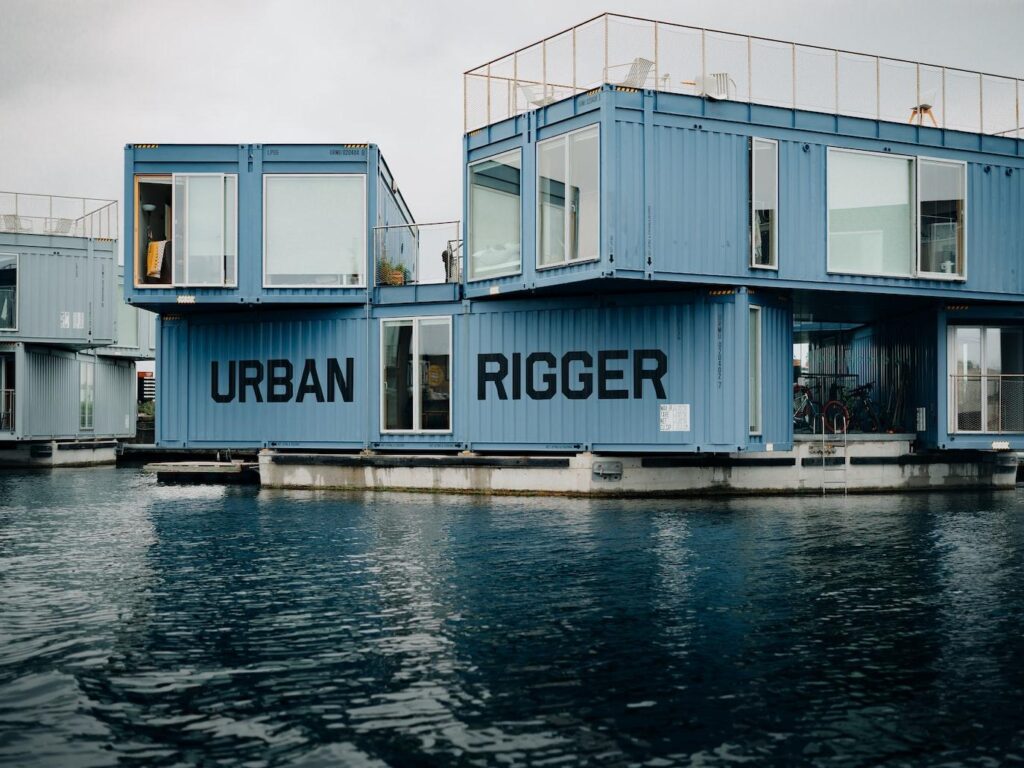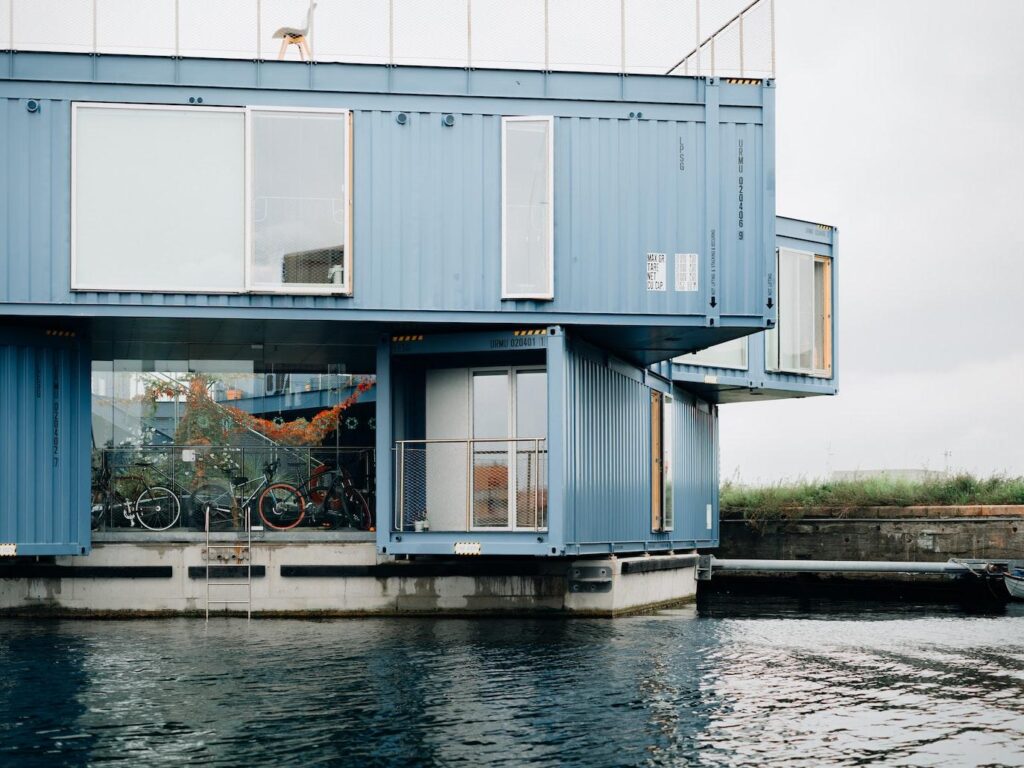Living in a shipping container house is a unique housing option that has become increasingly popular in recent years.
These unconventional dwellings have caught the attention of designers, architects, and homeowners alike, offering an innovative solution to building sustainable and affordable housing.
In this article, we will delve into the pros and cons of shipping container homes, providing you with insights and valuable tips.
Considering both the positives and negatives of living in a shipping container home can help you make an informed decision about whether it is the right option for you.
Let’s dive in!

Key Takeaways
- Living in a shipping container home can be an attractive and eco-friendly option for those looking for an affordable housing alternative.
- There are some drawbacks to consider before committing to this type of lifestyle. Space is a major consideration when opting for a container home.
- Due to the size of containers, it’s important to think about how much furniture you can fit inside.
- Insulating shipping containers in extreme climates can be difficult, as the metal walls may not provide adequate protection against extreme temperatures.
- Converting a shipping container into a livable space can be challenging since it must comply with local building codes.
- Maintenance and planning are key to getting the most out of this alternative housing choice. Investing time and effort in these areas will help create a unique and sustainable lifestyle without sacrificing comfort.
What Is a Shipping Container, and Why Is It So Popular?
Shipping container homes are made from repurposed shipping containers. These strong and durable containers were originally designed to transport goods over long distances.
This strength and durability also make them a viable option for an alternate living space.
These homes also promote sustainability as they are made from recycled materials. This helps reduce waste and conserve resources.
Many people also like the fact that hip-hop container homes can be customized to fit their needs and preferences.
However, there are some drawbacks to living in these homes.
Nevertheless, for those who want to reduce their environmental impact or live a minimalistic lifestyle, a shipping container home might be the perfect option.

Advantages Of Living In A Shipping Container House
Living in a container home has a variety of advantages. Here are a few reasons why:
They’re Cheaper to Construct
Shipping container homes are becoming an increasingly popular option for budget-conscious homebuyers. Not only are they more affordable than traditional homes, but they also offer a unique and eco-friendly living experience.
The construction of a shipping container home typically costs much less than traditional homes, with some premade models available for as little as $10,000.
For more luxurious options, you can expect to pay up to $35,000. Even larger container houses generally don’t exceed $185,000.
The affordability of shipping container homes is largely due to their small size and use of recycled materials, allowing you to save money while achieving your dream of homeownership.
The money you save can be used to invest in other aspects of your life or put towards other goals.



The Construction Takes Less Time
In contrast to traditional construction methods, constructing a container home can be done in as little as a month, drastically reducing the wait time.
This is especially useful for people who are relocating on a tight timeline or have deadlines for settling into their new home.
The speed of the construction process is made possible by the use of pre-existing shipping containers. Rather than having to build from the ground up, only modifications are required to make the container home structurally sound and meet local building codes.
Furthermore, insulation can be applied to the container during the construction process, increasing energy efficiency and providing thermal comfort.
The construction takes even less time if you want to build just a tiny home in your backyard. You can use this tiny home for rental purposes, like Airbnb.
The short construction period also allows for larger homes to be built in a timely manner. This means that homeowners can enjoy more spacious living areas without having to wait for long periods of time.
A More Eco-Friendly Option Than Traditional Homes
Building a shipping container home is a great way to reduce your environmental impact. Repurposing and recycling these containers means fewer materials go to landfills.
Using shipping containers instead of wood studs for construction reduces the amount of timber and resources needed, which helps preserve forests and natural habitats.
Container homes can be built quickly and with fewer materials, minimizing the energy used during construction. This makes them a more efficient choice than traditional building methods.
Many people are drawn to container homes due to their eco-friendly benefits. It is a great way to reduce your environmental footprint while also enjoying a unique living space.

It’s Quite Durable
Container homes offer an exceptional level of durability, making them ideal for those living in areas prone to extreme weather.
Shipping containers are made of strong steel, reinforced with additional beams and frames, and designed to resist winds up to 170 mph. This makes them especially suitable for those in hurricane- and tornado-prone regions.
This durable structure makes them a great choice for those who want to feel safe and secure from the elements.
They’re Highly Customizable
Shipping container homes are highly customizable, allowing you to create the home of your dreams.
Whether you prefer a traditional or modern style, there is a container home design that will suit your needs. Used shipping containers offer a wide range of floor plans and layouts to choose from.
You have the option to stack containers to add multiple floors or connect them in various ways to achieve different layouts.
However, it’s important to consider that downsizing from a typical container size may not be ideal for those who need more space.
To ensure that your container home reflects your unique style, it’s recommended to work with a local building professional. They can help you create a custom design that meets your specific requirements.
With endless possibilities, shipping containers offer a world of opportunity when it comes to building your dream home.
It’s an energy-efficient way of living.
Container living gives you an option for an energy-efficient lifestyle with just a few additional steps.
Firstly, maximize the efficiency of the layout by carefully planning the space. Installing energy-efficient windows and doors will help minimize heat loss or gain.
Secondly, use building materials that have high insulation properties, such as spray foam. This will enhance thermal performance and minimize air leakage, particularly in extreme weather conditions.
Remember to consider local regulations regarding modifications to shipping containers for residential use.
Disadvantages Of Living in A Shipping Container Home
Turning containers into a home comes with its own cons. These drawbacks are something you should also be well aware of because it’s hard to say what will happen during the actual building process.
Finding the Right Location Is Often Difficult
Finding the right location for a shipping container home can be a daunting task. It is important to understand your local regulations and zoning requirements before beginning your search.
The size of the container should also be taken into consideration. Container homes range from 160 to 320 square feet, so it is important to make sure the land you are looking at meets the requirements and can accommodate the size of the container.
When choosing the right location for your container home, think of proximity to work, school, family, friends, and amenities.
These are all important factors to consider when selecting the perfect spot for your home. Remember that while some areas may allow the construction of container homes, they may have specific codes and regulations that must be followed.
To ensure you find the best possible location for your container home, it is important to do your research. Check local regulations and zoning requirements to make sure you are in compliance with the law.
Also, make sure to consider the size of the container, the proximity to work, family, friends, and amenities, and any other codes or regulations that may apply.
Container Homes Are Not Always Eco-Friendly
Building a container home can be a great way to reduce your environmental footprint. However, it’s also worth noting that not all container homes are eco-friendly.
To ensure that your container home is as sustainable as possible, consider purchasing slightly used containers in good condition. These containers will be less likely to contain volatile chemicals and will be more solidly built.
Consider the size of the container you choose. Larger containers require more resources for construction and should be avoided if possible.
When building, make sure that your container home is equipped with the best insulation and energy-efficient appliances to minimize your environmental impact.
If you are considering building your home using new shipping containers, it is worth noting that traditional building methods often include more sustainable features. This could be a better option when it comes to reducing your environmental impact.
Shipping Container Homes Offer a Shorter Lifespan
On average, a shipping container home can last about 30 years with proper reinforcement and swift repairs. This is significantly shorter than the lifespan of traditional residential homes, many of which have been standing for over a century.
The longevity of a shipping container home mainly depends on the maintenance and care provided by its owners. Keeping the container intact and addressing any necessary repairs promptly are keys to extending its lifespan.

You May Gain Less Living Space in a Container Home
Living in a container home can be a great way to save money and minimize your living space. Container homes typically come in 20-foot and 40-foot sizes, offering about 160 and 320 square feet, respectively.
While you can connect multiple containers to make a larger home, this is usually more expensive and not as common.
If you prefer a minimalist lifestyle or live in an area with limited space, container homes could still be a great option for you.
If you decide that a container home is right for you, consider your lifestyle and how much space you’ll need. Be sure to measure the dimensions of the containers and plan out your furniture and other items to make sure everything fits. This will help ensure that you get the most out of the space available.
Some Tips for Container Home Living
If you’re set on choosing the container home lifestyle, then perhaps these tips can come in handy.
Maximize natural light
Position your shipping container in a way that allows ample natural light to enter. This not only saves energy but also promotes a brighter and more cheerful living space.

Insulate, insulate, insulate
As shipping containers are made of metal, they can quickly become hot or cold, depending on the weather. Invest in high-quality insulation to regulate temperatures and keep your home comfortable year-round.
Create functional spaces
Utilize the limited space efficiently by incorporating multi-purpose furniture and storage solutions. Think creatively to maximize every square inch, such as by installing loft beds or using vertical storage options.
Maintain good ventilation
Make sure your home has proper ventilation to prevent moisture buildup, which can lead to mold and mildew. Install vents, fans, or even windows with screens to allow for fresh air circulation.
Consider off-grid options
Explore sustainable alternatives like solar panels, rainwater collection systems, and composting toilets to reduce your ecological footprint. These off-grid solutions can make your shipping container home more environmentally friendly.
Opt for low-maintenance materials
Choose low-maintenance building materials for both the interior and exterior of your container home. This will make cleaning and upkeep easier, allowing you to spend more time enjoying your living space.
Prioritize security
Shipping containers can attract unwanted attention, so invest in robust locks, security cameras, and motion sensor lights to enhance the safety of your home. Consider fencing or landscaping that provides privacy and deters trespassers.
Personalize your space
Even though you’re living in a shipping container, that doesn’t mean you can’t make it feel like home. Incorporate your personal style through decorations, artwork, or even a small garden to create a cozy and inviting atmosphere.

Prepare for inclement weather
Depending on your location, extreme weather conditions could be a factor. Make sure your container home is equipped to handle heavy rains, strong winds, or snow by reinforcing the structure and sealing any potential leaks.
Stay connected with the community
Living in a shipping container home doesn’t mean you have to isolate yourself. Engage with local community groups or online forums to connect with others who have similar living arrangements. Sharing ideas and experiences can provide valuable support and inspiration.
Container Homes As A Modern Alternative Living Space
Living in a shipping container home can be a great way to save money and help the environment. It is also an incredibly creative housing option that can be tailored to fit your needs. Be mindful of the potential drawbacks and always plan ahead.
Remember, the key to successful shipping container home living is to adapt and embrace the unique challenges and opportunities it presents.
Enjoy the journey as you turn a humble shipping container into a comfortable, eco-friendly, and stylish living space.


